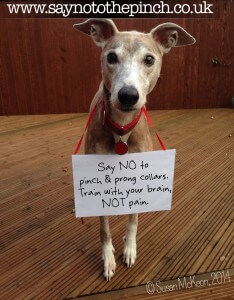Say NO to pinch, prong & shock collars
 At Happy Hounds Dog Training, we’re committed to using force-free training methods.
At Happy Hounds Dog Training, we’re committed to using force-free training methods.
We do not use or advocate any training methods that inflict pain, fear or suffering to a dog, which is why we are very much against the use of choke, pinch, prong or shock collars. Why would you want to use pain, when you can use your brain (and your dog’s) to accomplish a task?
Unfortunately, the sale and use of these types of collars isn’t banned in the UK (with the exception of shock collars in Wales). At the time of writing this blog post, there is a petition which is calling for an all-out ban on the sale and use of these collars in animal training. The petition can be found at: www.saynotothepinch.co.uk and is something we wholeheartedly support.
Our training methods
Our training methods are based on the way in which dogs (and humans learn). This is the ‘science’ of dog training and is known as learning theory. We like to think of this as the training equation, where what you add or subtract affects the outcome.
This training equation is made up of both positive and negative reinforcers and punishers, which all impact on either increasing or decreasing behaviours. Let us introduce you to the reinforcers and the punishers, which make up the training equation…
The reinforcers
When you use reinforcement in training, its role is to increase the frequency/likelihood of the desired behaviour.
There are two types of reinforcers:
- Positive reinforcement (R+) – where you add something to the equation, after the behaviour has been performed, to increase the frequency of it happening again. For example: You’re teaching loose lead walking, your dog walks 10 steps without pulling on the lead, you give your dog some liver cake (R+), play a game of tug (R+) or let them ‘go sniff’ (R+)
- Negative reinforcement (R-) – where you subtract (remove) something to the equation, to increase the frequency of the desired behaviour. Using our example of loose lead walking, R- is the loosening of the choke/pinch/prong collar after the dog stops pulling (you are subtracting the pain). The idea of this is that the dog will associate the cessation of pain with the act of walking on a loose lead and therefore the frequency of walking on a loose lead increases.
The punishers
When you use punishment in training, its role is to reduce the frequency/likelihood of the unwanted behaviour occurring and, just like the reinforcers, there are two types of punishment:
- Positive punishment (P+) – where you add something the dog finds aversive. The use of the word positive in this sense is purely to do with the addition of the punisher, not in the sense of the word as we would commonly use it. The addition of P+ causes a decrease in the unwanted behaviour. For example: You’re teaching loose lead walking using a choke/pinch/prong collar. When the dog pulls and the collar goes tight, the dog experiences pain and discomfort (P+). The addition of the pain aims to reduce the lead pulling.
However, one of the many side-effects of using P+ is that the dog may not associate the positive punishment with their behaviour. An example of this is: the dog is pulling on the lead and the choke/pinch/prong collar goes tight… on the other side of the road, there is a small child on a bike who appears at exactly the same time the dog experiences pain. Rather than associate the act of pulling on the lead = pain, the dog is more likely to associate small children on bikes = pain and, as you can imagine, this could lead to another unwanted behaviour whenever the dog sees a child on a bike.
- Negative punishment (P-) – where you subtract or remove punishment in the training equation. In this context, P- is the removal or withholding of R+. In our loose lead walking example, if the lead goes tight and the dog starts to pull we stop moving (we DO NOT yank or jerk the lead – that is P+) and do not give the dog any reinforcement (moving forward/food/game of tug/go sniff) – this is P-. We either wait for the lead to go loose, or we encourage the dog back to our side and take a step with a loose lead and then reinforce (R+) the step that is taken on a loose lead.
Which side of the training equation are you on?
At Happy Hounds we’re on the side of using our brain and NOT pain to train our dogs. We use force-free R+ (and P-) training methods and advocate reward based training only.
You can download our leaflet, which explains how reinforcement and punishment are used and why punishment doesn’t work by clicking here or clicking on the PDF icon at the end of this post.
Make your voice heard—join the campaign …
We are in 100% support of the campaign to ban the sale and use of pinch/prong collars in the UK and if you agree, please do sign the petition at: www.saynotothepinch.co.uk

